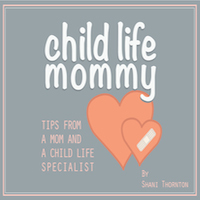
Meet Shani Thornton, my co-author this week!
Shani Thornton is a Certified Child Life Specialist and parent of two young children. She provides valuable information to child life specialists, parents and professionals working with kids. She is the author of a children’s book, It’s Time For Your Checkup What To Expect When Going To a Doctor Visit. To learn more about Shani, you can follow her blog at ChildLifeMommy.com or contact her at ChildLifeMommy@gmail.com
She is also on Twitter, Facebook, Pinterest and Instagram
We co-wrote pieces on adolescence this week. After you’ve read all about teens’ cognitive development here, head on over to Child Life Mommy for some practical tips and tricks for working with adolescents!
High school! Teenage years! Best years ever, am I right?
If you answered “yes,” I can only assume that you were one of the socially-gifted and confident high-schoolers that I could only admire from afar. If you, like me, answered with a big “h*** no!”, well, then, you and I have something in common.
Teenage years can be intensely difficult, and one of the reasons they can be is due to the massive changes occurring in the brain and endocrine system (which produces those famous teenage hormone surges). Let’s take a look at some of those changes:
There are physical changes to both the grey and white matter in the brain, starting just before puberty and continuing throughout adolescence.
- Grey matter is made up of neurons- those amazing little brain cells! (And just for a sense of scale, picture this: a millimeter-sized cube contains anywhere from 35 to 70 million neurons!) Right before puberty hits, there is a surge in grey matter in the brain; then during adolescence, the grey matter decreases.
- White matter is made up of synapses, coated with the protein myelin, which speeds the signal along synaptical connections. During adolescence, white matter increases. Researchers suggest that this could be the brain becoming more efficient in transferring information.
The brain circuitry necessary to process emotions is undergoing major change during adolescence. To complicate matters, the parts of the brain that involve the reward system (i.e. how we learn to motivate ourselves to make decisions) are tightly linked to this emotional response center. To sum up: most teens shouldn’t be expected to maturely process emotions, or respond in a positive or healthy way all the time, without lots of loving support and guidance.
There are enormous, uncontrollable hormonal changes, which, as we know, fuel sexual impulses, but also strongly influence social behavior and reactions to stress. This can help explain those lovely teen behaviors like (mild) bullying, clique formations, and sullenness towards parents and adults. Unless you’re seeing some major red flags (serious bullying, signs of depression, big changes in eating and/or sleeping, big changes in school performance, loss of interest in extracurricular activities), just know that these behaviors will run their course and this too, shall pass.
From a developmental perspective, i.e. combining the physical, social, cultural, and emotional changes during this period of life, most teenagers go through an intense identity crisis. Erik Erikson, one of the godfathers of developmental theory, called this stage “Identity versus Role Confusion,” and the big take-away from this part of his theory is that during the teenage years, most kids question who they are and what their role is in the world. No surprises there, right? Teens are transforming, in all ways, at a relatively high speed: there are new expectations placed on them, new responsibilities, and new pressures emerging in every domain of their lives, at the same time that their bodies are subjecting them to unprecedented change. It’s only natural that their previous sense of self falls apart, and leaves them feeling confused!
On a more encouraging note, a person’s ability to learn will never be higher than in their teenage years. Teens have an enormous capacity to take in new, diverse, and abstract information, and to process it with the speed of an adult brain. The teenage years can be difficult, but they are a wonderful, never-to-be-surpassed time of learning, wonder, curiosity, and growth!
Check out Child Life Mommy’s post for tips and tricks for working with teens!
Resources
Lightfoot, C., Cole, S., Cole M. (2008). Development of Children – Sixth Edition. Worth Publishers, Inc.: NY, NY.
National Institute of Mental Health. (2011). “The teen brain: still under construction.” NIH Publication No. 11-4929. Retrieved from http://www.nimh.nih.gov/health/publications/the-teen-brain-still-under-construction/index.shtml on November 13, 2014.
